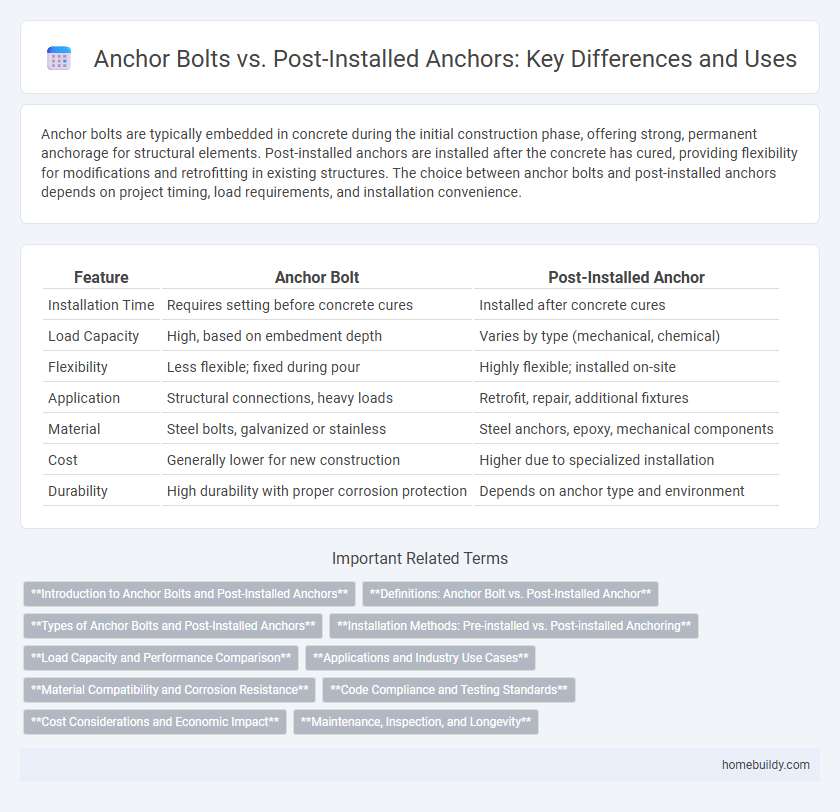Anchor bolts are typically embedded in concrete during the initial construction phase, offering strong, permanent anchorage for structural elements. Post-installed anchors are installed after the concrete has cured, providing flexibility for modifications and retrofitting in existing structures. The choice between anchor bolts and post-installed anchors depends on project timing, load requirements, and installation convenience.
Table of Comparison
| Feature | Anchor Bolt | Post-Installed Anchor |
|---|---|---|
| Installation Time | Requires setting before concrete cures | Installed after concrete cures |
| Load Capacity | High, based on embedment depth | Varies by type (mechanical, chemical) |
| Flexibility | Less flexible; fixed during pour | Highly flexible; installed on-site |
| Application | Structural connections, heavy loads | Retrofit, repair, additional fixtures |
| Material | Steel bolts, galvanized or stainless | Steel anchors, epoxy, mechanical components |
| Cost | Generally lower for new construction | Higher due to specialized installation |
| Durability | High durability with proper corrosion protection | Depends on anchor type and environment |
Introduction to Anchor Bolts and Post-Installed Anchors
Anchor bolts are fasteners embedded in concrete during the initial construction phase to securely attach structural elements, providing high load capacity and corrosion resistance. Post-installed anchors, installed after concrete curing, offer versatile solutions for retrofitting, repairs, or modifications with options like expansion anchors, adhesive anchors, and undercut anchors. Understanding the differences between embedded anchor bolts and post-installed anchors is crucial for selecting the appropriate fastening system based on structural requirements, load conditions, and installation constraints.
Definitions: Anchor Bolt vs. Post-Installed Anchor
Anchor bolts are embedded into concrete during the initial pouring process to provide a permanent mechanical fixture for structural components. Post-installed anchors are added after concrete curing, typically using mechanical expansion, adhesive bonding, or undercut methods to secure fixtures without prior embedded elements. Both serve to transfer loads but differ significantly in installation timing and application versatility.
Types of Anchor Bolts and Post-Installed Anchors
Anchor bolts include cast-in-place types such as J-bolts, L-bolts, and headed bolts embedded during concrete pouring, providing high structural integrity and precise placement. Post-installed anchors encompass expansion anchors, adhesive anchors, and undercut anchors, installed after concrete curing for flexible applications and repairs. Selecting between anchor bolts and post-installed anchors depends on project timing, load requirements, and installation conditions.
Installation Methods: Pre-installed vs. Post-installed Anchoring
Anchor bolts, embedded during concrete pouring as pre-installed anchors, offer precise alignment and load distribution tailored to structural requirements. Post-installed anchors, fixed into hardened concrete using mechanical expansion or adhesive bonding techniques, provide flexible installation options for retrofit applications. Choosing between pre-installed and post-installed anchoring depends on project timing, structural demands, and load conditions to ensure optimal performance.
Load Capacity and Performance Comparison
Anchor bolts typically offer higher load capacity due to their embedment depth and integrated design within concrete structures. Post-installed anchors, while versatile and easier to retrofit, generally exhibit lower load performance and are more sensitive to installation variables and concrete quality. Evaluating structural demands and installation conditions is crucial to selecting the optimal anchor type for maximum load-bearing efficiency and safety.
Applications and Industry Use Cases
Anchor bolts are primarily used in new construction projects to secure structural elements to concrete foundations, commonly found in industries such as commercial building, bridges, and heavy machinery installation. Post-installed anchors are preferred for renovation, repair, or retrofit applications where existing concrete structures need reinforcement or alterations, widely adopted in infrastructure maintenance and industrial facility upgrades. Both types serve critical roles in construction, with anchor bolts excelling in initial builds and post-installed anchors offering flexibility in modifications and safety enhancements.
Material Compatibility and Corrosion Resistance
Anchor bolts, typically made from galvanized steel or stainless steel, offer superior corrosion resistance when embedded in concrete, ensuring long-term durability in structural applications. Post-installed anchors, often crafted from carbon steel with protective coatings, may face compatibility challenges when paired with certain concrete types or environmental conditions, potentially leading to corrosion and reduced performance. Selecting the appropriate anchor type based on material compatibility and exposure conditions is crucial to maintaining structural integrity and preventing premature failure.
Code Compliance and Testing Standards
Anchor bolts are typically specified in accordance with building codes such as ACI 318 and must comply with ASTM standards like ASTM F1554 for tensile strength and ASTM A307 for general requirements. Post-installed anchors require rigorous testing following protocols such as ICC-ES AC308 or ACI 355.2 to ensure performance in concrete substrates, ensuring equivalency or superiority to cast-in anchor bolts.
Cost Considerations and Economic Impact
Anchor bolts generally offer lower initial costs compared to post-installed anchors due to simpler installation during the concrete pour, reducing labor and equipment expenses. Post-installed anchors incur higher expenses from specialized tools, labor, and potential downtime to retrofit existing structures, significantly impacting project budgets. Long-term economic impact favors anchor bolts in new construction projects, while post-installed anchors offer cost-effective solutions for modifications and repairs without extensive demolition.
Maintenance, Inspection, and Longevity
Anchor bolts typically require less frequent maintenance than post-installed anchors due to their embedded installation, which protects them from environmental exposure. Post-installed anchors need regular inspection for corrosion and mechanical wear, especially in high-moisture or chemically aggressive environments. Proper maintenance extends the longevity of both types, but embedded anchor bolts generally offer superior durability under long-term load conditions.
Anchor bolt vs Post-installed anchor Infographic

 homebuildy.com
homebuildy.com